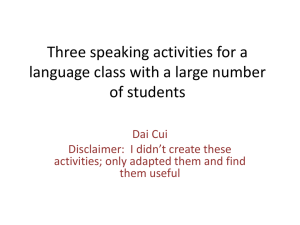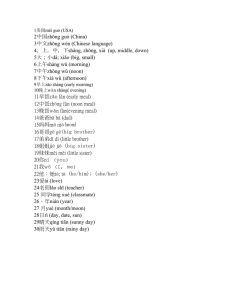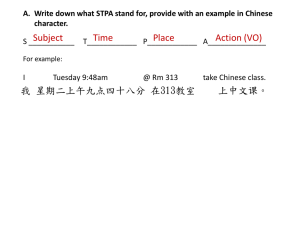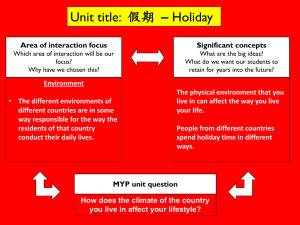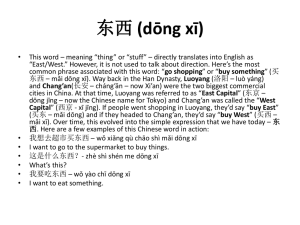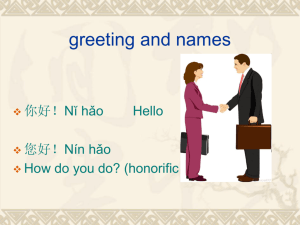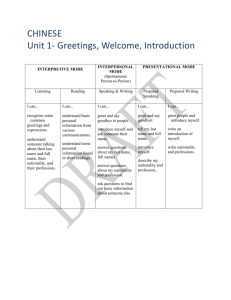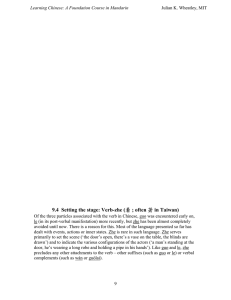CCSS Curriculum - Chinese at Chatterton
advertisement
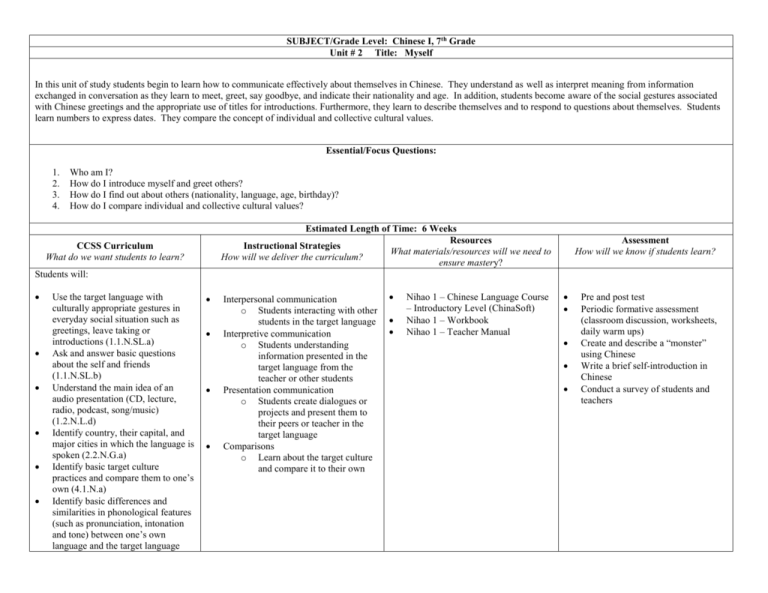
SUBJECT/Grade Level: Chinese I, 7th Grade Unit # 2 Title: Myself In this unit of study students begin to learn how to communicate effectively about themselves in Chinese. They understand as well as interpret meaning from information exchanged in conversation as they learn to meet, greet, say goodbye, and indicate their nationality and age. In addition, students become aware of the social gestures associated with Chinese greetings and the appropriate use of titles for introductions. Furthermore, they learn to describe themselves and to respond to questions about themselves. Students learn numbers to express dates. They compare the concept of individual and collective cultural values. Essential/Focus Questions: 1. 2. 3. 4. Who am I? How do I introduce myself and greet others? How do I find out about others (nationality, language, age, birthday)? How do I compare individual and collective cultural values? Estimated Length of Time: 6 Weeks Resources Instructional Strategies What materials/resources will we need to How will we deliver the curriculum? ensure mastery? CCSS Curriculum What do we want students to learn? Assessment How will we know if students learn? Students will: Use the target language with culturally appropriate gestures in everyday social situation such as greetings, leave taking or introductions (1.1.N.SL.a) Ask and answer basic questions about the self and friends (1.1.N.SL.b) Understand the main idea of an audio presentation (CD, lecture, radio, podcast, song/music) (1.2.N.L.d) Identify country, their capital, and major cities in which the language is spoken (2.2.N.G.a) Identify basic target culture practices and compare them to one’s own (4.1.N.a) Identify basic differences and similarities in phonological features (such as pronunciation, intonation and tone) between one’s own language and the target language Interpersonal communication o Students interacting with other students in the target language Interpretive communication o Students understanding information presented in the target language from the teacher or other students Presentation communication o Students create dialogues or projects and present them to their peers or teacher in the target language Comparisons o Learn about the target culture and compare it to their own Nihao 1 – Chinese Language Course – Introductory Level (ChinaSoft) Nihao 1 – Workbook Nihao 1 – Teacher Manual Pre and post test Periodic formative assessment (classroom discussion, worksheets, daily warm ups) Create and describe a “monster” using Chinese Write a brief self-introduction in Chinese Conduct a survey of students and teachers (4.2.N.d) Willingly use the target language within the classroom setting (5.2.N.a) Key Concepts Dates Greetings, leave-taking Interrogatives: Where are you from (country of origin)? Ni shi na guo ren? – What country are you from? Ni shi na guo ren? – What is your name? Ni jiao shenme mingzi? – How old are you this year? Ni jinnian ji sui? – How old are you? Ni duo da? Introductions: Name, age, country, phone number Phonemic awareness: phonetic alphabet song (learn Chinese With Me, p.5) tones, 4 tones Subject pronouns: Wo, Ni, Ta, Women, Nimen, Tamen Where are you from? (Ex: USA, China or other nations) Topics Greetings Leave taking Feelings Body Parts Vocabulary Bolded vocabulary are words students need to read and write. Non-bolded vocabulary are words students need to recognize only. 你nǐ - you 我wǒ – I / me 他tā – he 她tā – she 的 de – ‘s 是shì – is / am / are 叫jiào – name / shout / call / ask 什么shén me – what 好hăo – OK / good 很hěn – very 吗ma - ? 人rén – people 这 zhè - this 那 nà - that 大dà - big 小xiăo – small 呢 ne - ? 也 yĕ – also 早上 zăo shàng – morning 晚上 wăn shàng – evening 中午 zhōng wŭ – noon 谢谢 xiè xie - thanks 不客气 bú kè qì - not at all / you’re welcome 再见 zài jiàn – goodbye 哪 儿 nǎr – where 国 guó – country 家 jiā – home / family 在 zài – at / in / on 中国 zhōng guó – China 美国mĕi guó – USA 你们 nǐ mén - all of you 我们 wǒ mén - we / us 他们 tā mén – them / they 头发 tóu fà – hair 头 tóu – head 脸 liǎn – face 眉毛 méi máo – eyebrows 眼睛 yǎn jīng – eyes 鼻子 bí zi – nose 嘴 / 口zuĭ / kŏu – mouth 耳朵 ĕr duō - ears 手 shŏu – hands 脚 jiǎo – feet 肚子 dù zi- belly 女孩 nǚ hái - girl 男孩nán hái - boy 男人nán rén - man 女人nǚ rén – woman 高兴 gāo xìng - happy 快乐 kuài le – happy / cheerful 生气 shēng qì - angry / mad 疼 téng - hurts 怎么了 zěn me le / What’s wrong? / What happened? / What’s going on? 拉肚子 lā dù zi / diarrhea Sentence Patterns 你好! nǐ hǎo / Hello 我(他 / 她)叫__。wǒ (tā / tā) jiào / My name (his name / her name) is ____。 我(他 / 她) 是…。wǒ (tā / tā) shì / I am (he / she) is ___。 你(他 / 她)叫什么(名字)?nǐ(tā / tā) jiào shén me (míng zi)? / What’s your (his / her) name? 你好吗?nǐ hǎo ma? / How are you? 我很好。wǒ hěn hǎo. / I am very good. 你呢?nǐ ne? / And you? 我也很好。wǒ yě hěn hǎo. / I am also very good. 谢谢!xiè xiè / Thanks! 不客气。bú kè qì. / You’re welcome / not at all. 再见!zài jiàn ! / Goodbye! 你是哪国人?nǐ shì nă guó rén? / What’s your nationality? 你家在哪儿 / 哪里?nǐ jiā zài nǎr / nǎ lǐ? / Where do you live? / Where is your home? 早上好! zăo shàng hăo! / Good morning! 晚上好! wăn shàng hăo! / Good evening! 这是什么?zhè shì shén me? / What is this? 那是什么?zhè shì shén me? / What is that? 这是我的___。zhè shì wǒ de ___. / These are my ___. 你怎么了?nǐ zěn me le? / What is wrong with you? / What happen to you? / What’s going on with you? 我拉肚子了。wǒ lā dù zi le. / I have diarrhea. 我头疼。wǒ tóu téng. / My head hurts.
